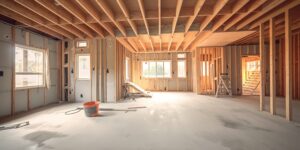While the overall 2023 housing market has been a bit “blah,” what’s happening in the build-to-rent sector is anything but. Things slowed down slightly to kick off the year, but it appears big things are ahead for BTR.
In fact, a difficult housing market—high prices, high interest rates, low inventory—has been a boost to build-to-rent. With market conditions keeping many would-be buyers from owning a home, BTR is becoming the next best option.
Once considered a potential fad, BTR has now become a major factor in real estate. Here’s a look at the BTR forecast and what that means for property managers.
What Is Build-to-Rent?
Build-to-rent homes share the concept of apartments but in the form of single-family houses. They are entire subdivisions of homes built exclusively for the purpose of renting. The neighborhood commonly offers shared amenities such as a pool, gym, or business center. The entire community is typically owned by institutional investors and professionally operated by a property management company. This is different than traditional single-family rental homes which tend to be geographically scattered and owned by individuals.
Who Is Living in BTR Homes?
BTR attracts a broad range of renters. One segment comprises affluent individuals with the means to own but who choose to rent largely because of convenience. They do not want to maintain a home. When something breaks, they can call the property manager. This also makes BTR especially attractive to baby boomers wanting to downsize their homes and enjoy retirement.
On the opposite end of the spectrum are those who cannot currently afford to own a home but want the lifestyle. They may not have the 20% downpayment to buy or are waiting a few years for mortgage rates to come down before entering the market. BTR presents a more affordable, flexible housing alternative.
The biggest group represents millennials. This generation is finally having children, which has them outgrowing apartment living. They want homes with more space, yards, and garages. The location of BTR homes also is a key factor. Living in the suburbs, having a community with other children, and proximity to good schools makes BTR a great option prior to permanently putting down roots.
What’s Happening in the BTR Market?
The broad demographic attracted to BTR homes supports the long-term growth projections for this model. Plus, high home prices and rising interest rates do not appear to be declining anytime soon. Institutional investors also have billions earmarked for build-to-rent communities which should keep the sector booming.
Between 1999 and 2022, BTR houses represented just 3% of all new home construction starts. That jumped to 7% in the last 12 months according to the Urban Institute. While BTR still represents just a fraction of overall homes today, housing expert Brad Hunter sees the number growing to 150,000 units per year by 2025—a significant uptick from what used to be 10,000 to 14,000 annually.
The current occupancy rate for BTR homes sits at about 97%, two points better than apartments. The demand for more rental homes exists, especially with a current U.S. affordable housing shortage of more than 3 million units according to Fannie Mae.
A slight BTR slowdown started in the fall of 2022 as the cost of borrowing increased and investors feared a recession. Many took a “let’s see what happens” approach. Now with concerns for an economic downturn lessening, investors are starting to inject capital back into BTR with builders breaking ground on communities across the country.
What Does BTR Mean for Property Managers?
One of the biggest changes BTR brings to property managers is with maintenance. Property managers accustomed to overseeing single-family rental homes should understand that BTR is different administratively—but not from the renter’s viewpoint.
Every BTR project comes with some sort of warranty negotiated between the investors and the builder as part of the contract process before construction even begins. As a result, every community may have a different warranty for the property manager to manage. This can be challenging, especially when it comes to working with builders on what constitutes a covered repair and executing fixes quickly to keep renters happy.
The community aspect of BTR homes helps property managers operate efficiently but also means the same malfunctions can happen across multiple homes at once. That can create an onslaught of repair issues with big price tags. Large communities of rental homes also mean constant maintenance calls for issues of all sizes and scope. Without increasing overhead, keeping up can be difficult.
Renters site maintenance problems as a key reason for leaving a rental property. They want fast, quality fixes and good communication. Managing 100-200 full homes within each subdivision can stretch property managers to the max. Poor service will lead to high turnover—and poor profits. That is not an option for institutional investors, which have clear financial projections for each BTR community. After all, most are reporting quarterly to shareholders.
The big takeaway: maintenance matters in multiple ways when it comes to BTR.
That is why more property owners, managers, and builders are turning to warranty experts for help. PWSC offers the industry’s only warranty program designed specifically for build-to-rent homes. The warranty provides a variety of options to insure systems, appliances, and other common home items—all with $0 service fees and $0 deductibles. With PWSC, BTR homes stay in great shape, retain their value, and keep renters happy. Learn more at https://www.pwsc.com/property-managers/build-to-rent-warranties/.




